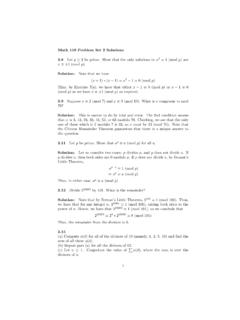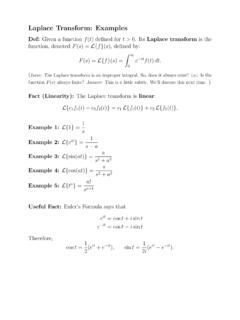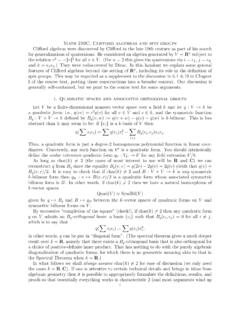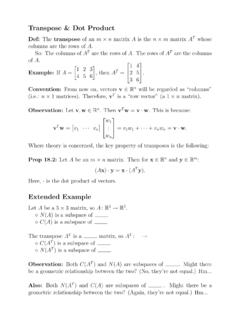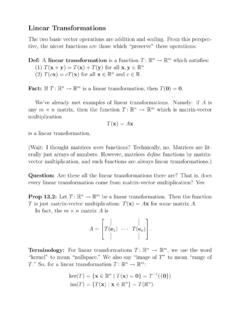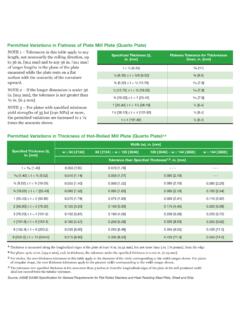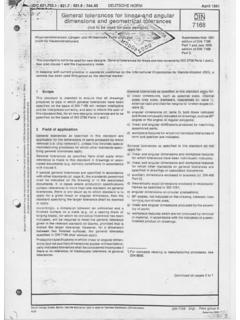Transcription of THE RISING SEA Foundations of Algebraic Geometry
1 THE RISING SEA. Foundations of Algebraic Geometry November 18, 2017 draft . c 2010 2017 by Ravi Vakil. Note to reader: the index and formatting have yet to be properly dealt with. There remain many issues still to be dealt with in the main part of the notes (including many of your corrections and suggestions). Contents Preface 11. For the reader 12. For the expert 16. Background and conventions 17. The goals of this book 18. Part I. Preliminaries 21. Chapter 1. Some category theory 23. Motivation 23. Categories and functors 25. Universal properties determine an object up to unique isomorphism 31. Limits and colimits 39. Adjoints 43. An introduction to abelian categories 47. Spectral sequences 57. Chapter 2. Sheaves 71. Motivating example: The sheaf of differentiable functions 71.
2 Definition of sheaf and presheaf 73. Morphisms of presheaves and sheaves 78. Properties determined at the level of stalks, and sheafification 82. Recovering sheaves from a sheaf on a base 86. Sheaves of abelian groups, and OX -modules, form abelian categories 89. The inverse image sheaf 92. Part II. Schemes 97. Chapter 3. Toward affine schemes: the underlying set, and topological space 99. Toward schemes 99. The underlying set of affine schemes 101. Visualizing schemes I: generic points 113. The underlying topological space of an affine scheme 115. A base of the Zariski topology on Spec A: Distinguished open sets 118. Topological (and Noetherian) properties 119. The function I( ), taking subsets of Spec A to ideals of A 127. Chapter 4. The structure sheaf, and the definition of schemes in general 129.
3 The structure sheaf of an affine scheme 129. Visualizing schemes II: nilpotents 133. 3. Definition of schemes 136. Three examples 139. Projective schemes, and the Proj construction 145. Chapter 5. Some properties of schemes 153. Topological properties 153. Reducedness and integrality 155. Properties of schemes that can be checked affine-locally 157. Normality and factoriality 161. The crucial points of a scheme that control everything: Associated points and primes 166. Part III. Morphisms 175. Chapter 6. Morphisms of schemes 177. Introduction 177. Morphisms of ringed spaces 178. From locally ringed spaces to morphisms of schemes 180. Maps of graded rings and maps of projective schemes 186. Rational maps from reduced schemes 188. Representable functors and group schemes 194.
4 The Grassmannian (initial construction) 199. Chapter 7. Useful classes of morphisms of schemes 201. An example of a reasonable class of morphisms: Open embeddings 201. Algebraic interlude: Lying Over and Nakayama 203. A gazillion finiteness conditions on morphisms 207. Images of morphisms: Chevalley's Theorem and elimination theory 216. Chapter 8. Closed embeddings and related notions 225. Closed embeddings and closed subschemes 225. More projective Geometry 230. The (closed sub)scheme-theoretic image 236. Effective Cartier divisors, regular sequences and regular embeddings240. Chapter 9. Fibered products of schemes, and base change 247. They exist 247. Computing fibered products in practice 253. Interpretations: Pulling back families, and fibers of morphisms 256. Properties preserved by base change 262.
5 Properties not preserved by base change, and how to fix them 263. Products of projective schemes: The Segre embedding 271. Normalization 273. Chapter 10. Separated and proper morphisms, and (finally!) varieties 279. Separated morphisms (and quasiseparatedness done properly) 279. Rational maps to separated schemes 289. Proper morphisms 293. Part IV. Geometric properties: Dimension and smoothness 301. Chapter 11. Dimension 303. Dimension and codimension 303. Dimension, transcendence degree, and Noether normalization 307. Codimension one miracles: Krull's and Hartogs's Theorems 315. Dimensions of fibers of morphisms of varieties 322. Proof of Krull's Principal Ideal and Height Theorems 327. Chapter 12. Regularity and smoothness 331. The Zariski tangent space 331. Regularity, and smoothness over a field 337.
6 Examples 342. Bertini's Theorem 346. Another (co)dimension one miracle: Discrete valuation rings 349. Smooth (and e tale) morphisms (first definition) 354. Valuative criteria for separatedness and properness 358. More sophisticated facts about regular local rings 362. Filtered rings and modules, and the Artin-Rees Lemma 364. Part V. Quasicoherent sheaves 367. Chapter 13. Quasicoherent and coherent sheaves 369. Vector bundles and locally free sheaves 369. Quasicoherent sheaves 375. Characterizing quasicoherence using the distinguished affine base 377. Quasicoherent sheaves form an abelian category 381. Module-like constructions 383. Finite type and coherent sheaves 386. Pleasant properties of finite type and coherent sheaves 389. Coherent modules over non-Noetherian rings 393.
7 Chapter 14. Line bundles: Invertible sheaves and divisors 397. Some line bundles on projective space 397. Line bundles and Weil divisors 400. Effective Cartier divisors = invertible ideal sheaves 408. Chapter 15. Quasicoherent sheaves and projective A-schemes 411. The quasicoherent sheaf corresponding to a graded module 411. Invertible sheaves (line bundles) on projective A-schemes 412. Globally generated and base-point-free line bundles 413. Quasicoherent sheaves and graded modules 416. Chapter 16. Pushforwards and pullbacks of quasicoherent sheaves 421. Introduction 421. Pushforwards of quasicoherent sheaves 421. Pullbacks of quasicoherent sheaves 422. Line bundles and maps to projective schemes 428. The Curve-to-Projective Extension Theorem 435. Ample and very ample line bundles 437.
8 The Grassmannian as a moduli space 442. Chapter 17. Relative versions of Spec and Proj, and projective morphisms 447. Relative Spec of a (quasicoherent) sheaf of algebras 447. Relative Proj of a sheaf of graded algebras 450. Projective morphisms 453. Applications to curves 459.. Chapter 18. Cech cohomology of quasicoherent sheaves 465. (Desired) properties of cohomology 465. Definitions and proofs of key properties 470. Cohomology of line bundles on projective space 475. Riemann-Roch, degrees of coherent sheaves, and arithmetic genus 477. A first glimpse of Serre duality 485. Hilbert functions, Hilbert polynomials, and genus 488. Serre's cohomological characterization of ampleness 494. Higher pushforward (or direct image) sheaves 497. From projective to proper hypotheses: Chow's Lemma and Grothendieck's Coherence Theorem 501.
9 Chapter 19. Application: Curves 505. A criterion for a morphism to be a closed embedding 505. A series of crucial tools 507. Curves of genus 0 510. Classical Geometry arising from curves of positive genus 511. Hyperelliptic curves 514. Curves of genus 2 518. Curves of genus 3 519. Curves of genus 4 and 5 521. Curves of genus 1 523. Elliptic curves are group varieties 532. Counterexamples and pathologies using elliptic curves 538. Chapter 20. Application: A glimpse of intersection theory 543. Intersecting n line bundles with an n-dimensional variety 543. Intersection theory on a surface 547. The Grothendieck group of coherent sheaves, and an Algebraic version of homology 554. The Nakai-Moishezon and Kleiman criteria for ampleness 556. Chapter 21. Differentials 561. Motivation and game plan 561.
10 Definitions and first properties 562. Smoothness of varieties revisited 575. Examples 578. Understanding smooth varieties using their cotangent bundles 583. Unramified morphisms 588. The Riemann-Hurwitz Formula 589. Chapter 22. Blowing up 597. Motivating example: blowing up the origin in the plane 597. Blowing up, by universal property 599. The blow-up exists, and is projective 603. Examples and computations 608. Part VI. More 619. Chapter 23. Derived functors 621. The Tor functors 621. Derived functors in general 625. Derived functors and spectral sequences 629. Derived functor cohomology of O-modules 634.. Cech cohomology and derived functor cohomology agree 637. Chapter 24. flatness 645. Introduction 645. Easier facts 647. flatness through Tor 652. Ideal-theoretic criteria for flatness 654.


